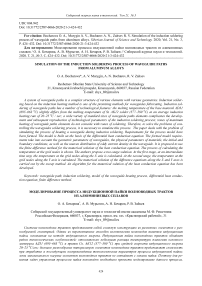Simulation of the induction soldering process of waveguide paths from aluminum alloys
Автор: O. A. Bocharova, A. V. Murygin, A. N. Bocharov, R. V. Zaitsev
Журнал: Siberian Aerospace Journal @vestnik-sibsau-en
Рубрика: Technological processes and material science
Статья в выпуске: 3 vol.21, 2020 года.
Бесплатный доступ
A system of waveguide paths is a complex structure of various elements with various geometries. Induction soldering based on the induction heating method is one of the promising methods for waveguides fabricating. Induction soldering of waveguide paths has a number of technological features: the melting temperature of the base material AD31 (695–663 0C) slightly differs from the melting temperature of St. AK12 solder (577–580 0C) at an average induction heating rate of 20–25 0C / sec; a wide variety of standard sizes of waveguide paths elements complicates the development and subsequent reproduction of technological parameters of the induction soldering process; zones of maximum heating of waveguide paths elements do not coincide with zones of soldering. Therefore, to solve the problems of controlling the waveguides soldering process, it is necessary to simulate this process. The paper deals with the problem of simulating the process of heating a waveguide during induction soldering. Requirements for the process model have been formed. The model is built on the basis of the differential heat conduction equation. The formed model requirements take into account the geometric parameters of waveguides, the physical parameters of materials, the initial and boundary conditions, as well as the uneven distribution of eddy current density in the waveguide. It is proposed to use the finite difference method for the numerical solution of the heat conduction equation. The process of calculating the temperature at the grid nodes is shown. The authors propose a two-stage solution. At the first stage, at an intermediate time step, the temperature at the grid nodes along the X axis is calculated. At the second stage, the temperature at the grid nodes along the Y axis is calculated. The numerical solution of the difference equations along the X and Y axes is carried out by the sweep method. An algorithm for the numerical solution of the heat conduction equation has been developed.
Waveguide path, induction soldering, model of the waveguide heating process, differential heat conduction equation, finite difference method.
Короткий адрес: https://sciup.org/148321765
IDR: 148321765 | УДК: 004.942 | DOI: 10.31772/2587-6066-2020-21-3-424-432
Список литературы Simulation of the induction soldering process of waveguide paths from aluminum alloys
- Zlobin S. K., Mikhnev M. M., Laptenok V. D., Bocharov A. N., Dolgopolov B. B. [Features of production of waveguide-distribution paths of antenna-feeder devices of space vehicles]. Vestnik SibGAU. 2013, No 6, P. 196–201 (In Russ.).
- Brovko A. V. [Problems of automatic welding of radar waveguides]. Izvestiya vuzov: Mashinostroenie. 2013, No. 1, P. 50–54 (In Russ.).
- Bushminsky I. P. Izgotovlenie ehlementov konstruktsii SVCh. Volnovody i volnovodnye ustroistva [Manufacturing of elements of microwave structures. Waveguides and waveguide devices]. Moscow, Vysshaya hkola Publ., 1974, P. 304.
- Full in-house production facilities. Available at: http://www.advancedmicrowave.com/our-facilities (accessed: 10.05.2020).
- Pamin S. et al. Joining of aluminum waveguides using pulsed laser radiation. Microwave Conference (APMC), 2015 Asia-Pacific. – IEEE, 2015, vol. 3, P. 1–3.
- Rapoport E., Pleshivtseva Y. Optimal Control of Induction Heating Processes. CRC Press, NY, 2007, 349 p.
- Zlobin S. K. [Features of soldering elements of waveguide-distribution paths from aluminum alloys with the use of an induction heating source]. Мaterialy XVI Mezhdunar. nauch. konf. “Reshetnevskie chteniya” [Materials XVI Intern. Scientific. Conf “Reshetnev reading”]. Krasnoyarsk, 2012, Vol. 1, P. 16–17 (In Russ.).
- Bocharova O. A., Tynchenko V. S., Bocharov A. N., Oreshenko T. G., Murygin A. V., Panfilov I. A. Induction heating simulation of the waveguide assembly elements. Journal of Physics: Conference Series. 2019, Vol. 1353, P. 012040.
- Patidar B., Hussain M. M., Sanjoy Das, Mukherjee D, Tiwari A. P. Simulation and Experimental Validation of Induction Heating of MS Tube for Elevated Temperature. NDT Application Excerpt from the Proceedings of the COMSOL Conference in Pune, 2015, 6 p.
- Rhein S., Tilman U., Knut G. Optimal control of induction heating processes using FEM software. Conference: 2015 European Control Conference (ECC), 2015, P. 515–520.
- Lykov A. V. Teoriya teploprovodnosti [Theory of thermal conductivity]. Moscow, Vysshaya shkola Publ., 1967, 599 p.
- Babat G. I. Induktsionnyi nagrev metallov i ego promyshlennoe primenenie [Induction heating of metals and its industrial application]. Moscow – Leningrad, Energy Publ., 1965, 552 p.
- Paskonov V. M., Polezhaev V. I., Chudov L. A. Chislennoe modelirovanie protsessov teplo-massoobmena [Numerical modeling of heat and mass transfer processes]. Moscow, Nauka Publ., 1984, 288 p.
- Patankar S. V., Kalabin E. V., Yankov G. G. Chislennoe reshenie zadach teploprovodnosti i konvektivnogo teploobmena pri techenii v kanalakh [Numerical solution of problems of thermal conductivity and convective heat transfer during flow in channels]. Moscow, Mehi Publ., 2003, 312 p.
- Samara A. A. Teoriya raznostnykh skhem [Theory of difference schemes]. Moscow, Nauka Publ., 1977, 388 p.
- Zlobin S. K., Mikhnev M. M., Laptenok V. D., Seregin Yu. N., Bocharov A. N., Tynchenko V. S., Dubets Yu. P., Dolgopolov B. B. [Automated equipment and technology for soldering waveguide paths of spacecraft]. Vestnik SibGAU. 2014, No. 4 (56), P. 219–229 (In Russ.).
- Murygin A. V., Tynchenko V. S., Laptenok V. D., Emilova O. A., Seregin Y. N. Modeling of thermal processes in waveguide tracts induction soldering. IOP Conference Series: Materials Science and Engineering. 2017, Vol. 173(1), P. 012026.


